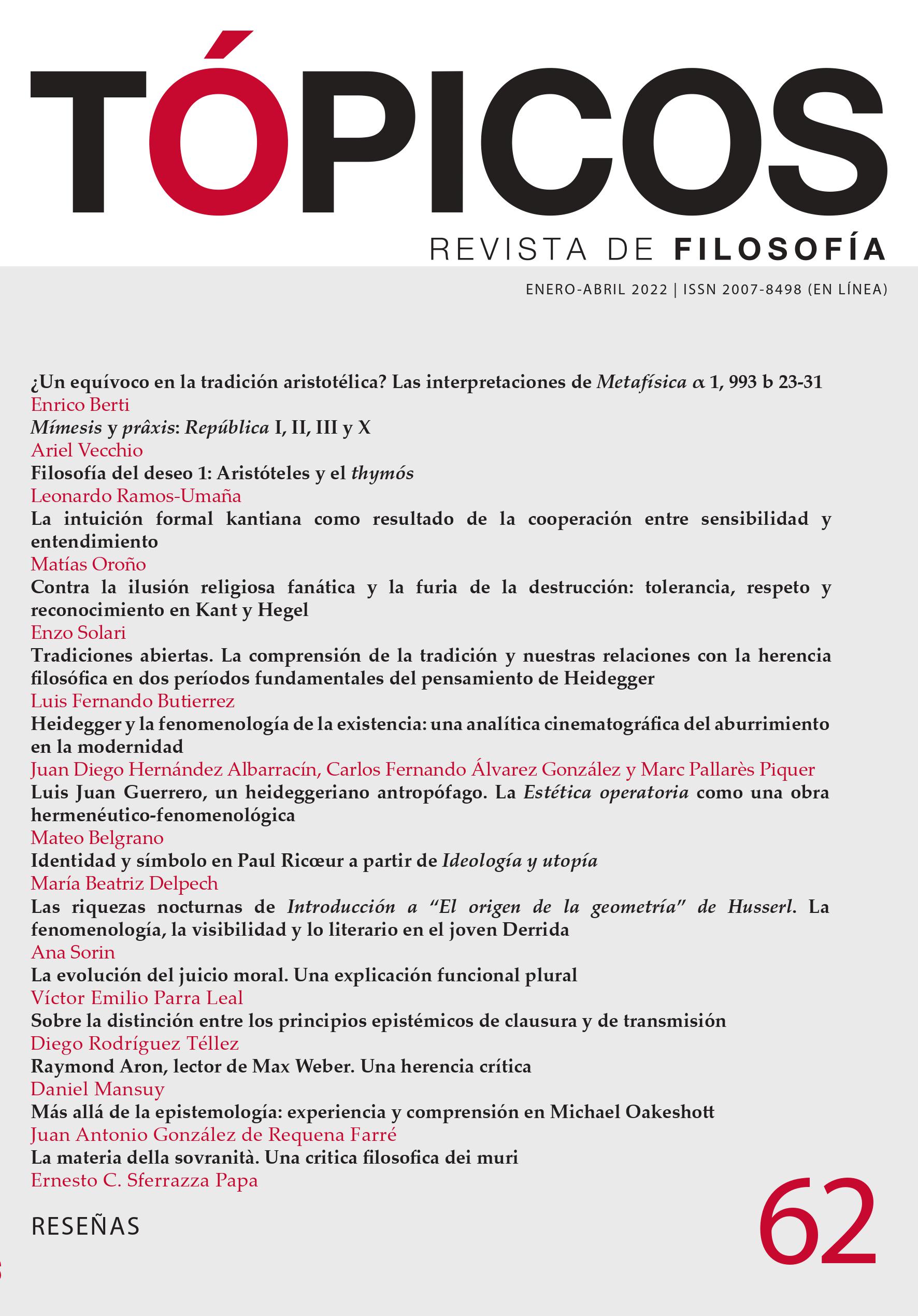Published 2021-12-11
Keywords
How to Cite
Copyright (c) 2021 Tópicos, Revista de Filosofía

This work is licensed under a Creative Commons Attribution-NonCommercial-NoDerivatives 4.0 International License.
Downloads
Altmetrics
Citas
Abstract
Despite the postmodern image of a smooth and borderless world, physical barriers currently represent one of the most important instruments of political articulation of the statal space. However, several ethical and political problems arise from it. This paper presents a philosophical critique of teichopolitical rationalities, namely, the politics of walls. The first section analyses two ancient teichopolitical paradigms. The second section analyses the wall as an element that nullifies the image of a global borderless world. The third section deals with the wall as a protective instrument of the statal body. The fourth section highlights the ethical and political problems produced by walls. In the fifth section we argue that walls represent a spectacularized form of sovereignty. In the conclusions I summarize the results and suggest that teichopolitical logics foment a feeling of paranoia on a global level.
References
- Anzieu, D. (2005). L’io-pelle. A. Verdolin (trad.). Borla.
- Aristotele. (1955). Politica e Costituzione di Atene. C. A. Viano e M. Zanatta (trad.). UTET.
- Badie, B. (1996). La fine dei territori. Saggio sul disordine internazionale e sull’utilità sociale del rispetto. M. Cadorna (trad.). Asterios.
- Badie, B. (2000). Il mondo senza sovranità. Gli Stati tra astuzia e responsabilità. M. Ravalico (trad.). Asterios.
- Ballif, F. & Rosière, S. (2009). Le défi des «teichopolitiques». Analyser la fermeture contemporaine des territoires. Espace géographique, 3(38), 193-206.
- Bauman, Z. (2002). La società sotto assedio. S. Minucci (trad.). Laterza.
- Bauman, Z. (2008). Modernità liquida. S. Minucci (trad.). Laterza.
- Beck, U. (2000). La società del rischio. Verso una seconda modernità. W. Privitera (trad.). Carocci.
- Benjamin, W. (1999). Il dramma barocco tedesco. F. Cuniberto (trad.). Einaudi.
- Berti, E. (1997). Aristotele. Laterza.
- Brown, W. (2013). Stati murati, sovranità in declino. S. Liberatore (trad.). Laterza.
- Callahan, W.A. (2018). The Politics of Walls: Barriers, Flows, and the Sublime. Review of International Studies, 3(44), 456-481.
- Cambiano, G. (2016). Come mare in tempesta. Il governo della città in Platone e Aristotele. Laterza.
- Canetti, E. (1981). Massa e potere. F. Jesi (trad.). Adelphi.
- Chamayou, G. (2014). Teoria del drone. Principi filosofici del diritto di uccidere. M. Tari. (trad.). DeriveApprodi.
- Cuozzo, G. (2017). Esercizi spirituali, horologia e mistica protocollare.Da Ignacio di Loyola a Franz Kafka. Filosofia, 4, 10-23.
- De Genova, N. (2012). Border, Scene and Obscene. In T. Wilson & H. Donnan (a cura di), A Companion to Border Studies. (pp. 492-504).
- Wiley-Blackwell.
- Esposito, R. (2002). Immunitas. Protezione e negazione della vita. Einaudi.
- Foessel, M. (2016). État de vigilance. Critique de la banalité sécuritaire. Éditions du Seuil.
- Foucault, M. (2015). Sorvegliare e punire. Nascita della prigione. A. Tarchetti (trad.). Einaudi.
- Graglia, P. S. (2019). Il muro. Berlino e gli altri. Gallarate.
- Hobbes, T. (2011). Leviatano o la materia, la forma e il potere di uno Stato ecclesiastico e civile. A. Lupoli, M. V. Predaval e R. Rebecchi (trad.). Laterza.
- Hodder, I. (2012). Entangled. An Archaeology of the Relationships between Human and Things. Wiley-Blackwell.
- Jameson, F. (2007). Il postmoderno, ovvero la logica culturale del tardo capitalismo. M. Manganelli (trad.). Fazi.
- Kafka, F. (1970). Racconti. E. Pocar (trad.). Mondadori.
- Kraepelin, E. (1982). La folie systématisée (paranoïa). Analytica, 30, 21-44.
- Lyotard, F. (1981). La condizione postmoderna: rapporto sul sapere. C. Formenti (trad.). Feltrinelli.
- Mbembe, A. (2003). Necropolitics. Public Culture, 1(15), 11-40.
- Nail, T. (2016a). A Tale of Two Crises: Migration and Terrorism after the Paris Attack. Studies in Ethnicity and Nationalism, 1(16), 158-167.
- Nail, T. (2016b). Theory of the Border. Oxford University Press.
- Ohmae, K. (1990). The Borderless World. Power and Strategy in the Interlinked Economy. Collins.
- Platone. (2005). Le leggi. F. Ferrari e S. Poli (trad.). Rizzoli.
- Quétel, C. (2013). Muri. Un’altra storia fatta dagli uomini. M. Botto (trad.). Bollati Boringhieri.
- Razac, O. (2001). Storia politica del filo spinato. La prateria, la trincea, il campo di concentramento. G. Morosato e I. Bussoni (trad.). Ombre corte.
- Ricoeur, P. (1990). Soi-même comme un autre. Éditions du Seuil.
- Schmitt, C. (2011a). Il nomos della terra nel diritto internazionale dello «jus publicum europaeum». E. Castrucci (trad.). Adelphi.
- Schmitt, C. (2011b). Terra e mare. Una riflessione sulla storia del mondo. G. Gurisatti (trad.). Adelphi.
- Sferrazza Papa, E. C. (2018). What is a Wall? Towards an Ontology of Political Artefacts. Rivista di Estetica, 1(67), 80-96.
- Sferrazza Papa, E. C. (2019). Modernità infinita. Saggio sul rapporto tra spazio e potere. Mimesis.
- Shamir, R. (2005). Without Borders? Notes on Globalization as a Mobility Regime. Sociological Theory, 2(23), 197-217.
- Simmel, G. (1989). Sociologia. G. Giordano (trad.). Edizioni di Comunità.
- Vattimo, G. (1985). La fine della modernità. Nichilismo ed ermeneutica nella cultura postmoderna. Garzanti.
- Virilio, P. (1981). Velocità e politica. Saggio di dromologia. L. Sardi-Luisi (trad.). Multhipla.
- Virilio, P. (2008). Bunker archéologie. Études sur l’espace militaire européen de la Seconde Guerre mondiale. Galilée.
- Winner, L. (1980). Do Artifacts Have Politics? Daedalus, 1(109), 121-136.






